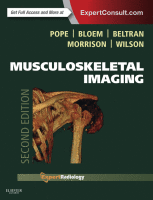Physical Address
304 North Cardinal St.
Dorchester Center, MA 02124

Technical Aspects Conventional Radiography ( eTable 30-1 ) eTABLE 30–1 Radiographic Projections Projection Anatomy/Indication Routine Toe (Coned) Anteroposterior toes only Tufts, subungual, interphalangeal space Anteroposterior foot Intertarsal space, metatarsophalangeal joints Oblique toes only Bone contours, phalanges Lateral toes only Dislocation…

Prevalence, Epidemiology, and Definitions The term osteochondral lesion is used to describe a defect of the articular surface involving separation of the cartilage and the underlying bone, without making any pretense to etiology. Possible causes of osteochondral lesions are traumatic…

The Extensor Apparatus The extensor apparatus consists of the quadriceps tendon, the patella, the patellar tendon, the infrapatellar fat pad, and the medial and lateral patellar retinacula. Quadriceps Tendon Rupture Anatomy The quadriceps tendon is the conglomeration of the distal…

Anterior Cruciate Ligament Prevalence, Epidemiology, and Definitions Injury to the anterior cruciate ligament (ACL) represents the most important ligament injury around the knee. It is relatively uncommon in the general population but is an important cause of injury in individuals…

Normal Anatomy The menisci are C-shaped disks of fibrocartilage located between the articular surfaces of the femoral condyles and the tibia. The peripheral margin of each meniscus is thick and convex and tapers to a thin margin at the free…

Prevalence, Epidemiology, and Definitions The imager's role in diagnosis and treatment of knee trauma is not only to accurately identify specific injuries, but also to recognize patterns of imaging findings that suggest that further investigation is warranted. It may be…

Imaging Techniques Technical Aspects Standard radiographs of the knee are performed as the first-line examination in knee disorders. Radiographs include anteroposterior and lateral views of the entire knee, as well as axial views of the patellofemoral joint ( eFig. 24-1…

Anatomy of the Hip Joint The hip is a ball-and-socket joint allowing a wide range of motion in all directions. Active movements (flexion, extension, adduction, abduction, circumduction, and medial and lateral rotations) are possible. The femoral head is nearly completely…

Radiologic Anatomy of the Proximal Femur A thorough knowledge of radiologic anatomy and anatomic variations of the proximal femur is required for interpreting hip studies. Although excellent descriptions of femoral anatomy are readily available in classic textbooks, volume-rendered multidetector computed…

Pelvic Anatomy in Relation to Pubalgia The pubic symphysis is a nonsynovial, amphiarthrodial joint formed by the confluence of the two pubic bodies with an intervening articular disk ( Fig. 21-1 ). The medial surface of the body forms the…